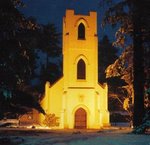Last night we had a wonderful Spaghetti Dinner to raise funds for our Towel Camp trip to Appalachia. To be honest, the turnout far exceeded my expectations -- oh ye of little faith. To watch friends from different circles, different churches, different walks of life come together -- and eat together -- was a joy.
But it wasn't the money raised that filled my heart. It wasn't even the full parish hall, even though I was thrilled when we had to set up an extra table. What made me know all was well was watching the kids and several dedicated adults working and laughing together, hours before the dinner began. And then, afterward, watching them sit and eat together.
You could see Christ at work in all that food.
Which brings us to the gospel.
You know the story of the Walk to Emmaus. Two disciples (why only Cleopas gets named, I don't know) are walking away from Jerusalem toward Emmaus when they are joined by a stranger who asks what they're talking about. They are amazed that he doesn't know. As one of our bible study participants put it this week, they might have been tempted to ask, "Have you been under a rock or something?" But then Jesus could have answered, "Well, yes, actually."
Anyway, Jesus, whose identity remains hidden from them, begins to explain what the crucifixion meant, how it was inevitable, and how the resurrection was just as real as the report those two disciples had heard. Finally, they reach their destination and invite the stranger to stay with them because it's late. And there, when Jesus breaks bread with them, they recognize him for who he is.
One question you might ask is, how could these guys not recognize Jesus? There are several responses. First of all, we all know how meeting someone out of context can be confusing. More than once, I've been in my jeans and a t-shirt and run into parishioners or folks from the nursery school who look at me, and you can see in it in their eyes: "I think I've met this guy before, but who is he?" When you consider that Jesus was supposed to be dead, you can forgive these disciples for not catching on right away.
But it's equally likely that they don't recognize Jesus because he was changed -- this isn't the first story where a close disciple doesn't recognize him after the resurrection. We could spend a lot of time wondering just how Jesus changed.
But what's more important is how they recognized him. It wasn't in the teaching he gave them on the road. It wasn't in his appearance. It was in the breaking of bread.
Why would that be?
Context. They recognize him through the blessing and sharing. There is something about Jesus and feeding. Like the feeding of the 5,000 or the less famous feeding of the 4,000 story. Or like the last supper when Jesus takes bread, blesses it, breaks it and gives it to the disciples saying, Take, eat. This is my Body which is given for you. Do this in remembrance of me."
Only after he does this do all of Jesus' words make sense. Only after he breaks bread can they see again the well-known contours of his face. Jesus is the bread of heaven, and in the breaking of bread.
This sharing bread has one other feature that you should know. It shows these disciples that he is real, no mere ghost. As if to prove it, after the two run back to Jerusalem -- and remember, it's dark now -- and meet the other disciples to tell them their experience, Jesus appears before them all. And what does he do? He says, "You got anything to eat? Because ghosts don't eat."
He is real. He is risen.
This story in which the disciples know him in the breaking of the bread is also important to us because it emphasizes the power of one of Jesus' final commands to the disciples before he was arrested. Take, eat. This is my Body.
The bread we share in the Eucharist, the bread we break together -- it is Christ's body. And in break it together, we can recognize him. Just like those two on the road to Emmaus, we may not recognize him in all the words we hear (even in scintilating sermons) or in the faces of everyone around us. But when we share the Body of Christ in the breaking of bread, we can indeed recognize him. This bread, this common food, this sharing is Jesus' context.
I rejoice in our common meals, be they spaghetti or eucharist, because in them I see the face of Christ. And I give thanks. Amen.




